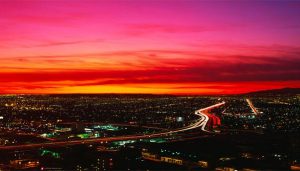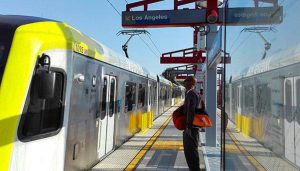 Leave the car at home, and avoid ending up stuck in traffic on one of America’s busiest highways. Instead, hop on a metro line that runs below Los Angeles and the Santa Monica mountains, and emerges several kilometres away.
Leave the car at home, and avoid ending up stuck in traffic on one of America’s busiest highways. Instead, hop on a metro line that runs below Los Angeles and the Santa Monica mountains, and emerges several kilometres away.
The route would start at Los Angeles International Airport, cross Westside, pass through the Santa Monica mountains and end in the San Fernando Valley. The Los Angeles County Metropolitan Transportation Authority (METRO) calls it the Sepulveda Transit Corridor, and it is one of the most important sustainable mobility projects in the United States.
The price tag would be high, varying between $9 billion and $14 billion. The goal is to create an alternative underground route to the I-405 Freeway, which entraps more than 400,000 people every day in traffic, people who are forced to take it to go to school or work or elsewhere.
The Sepulveda Transit Corridor: residents clamour for public transport
Over an hour to travel about 10 kilometres (six miles) of freeway. This is the sad tale recounted by several commuters in a video published on the METRO website. The I-405 is a nightmare, and the public has high hopes for a transport alternative.
The Sepulveda Transit Corridor project aims to offer an alternative to the endemic road transport congestion in Los Angeles, which has reached alarming levels. That’s why METRO launched a series of feasibility studies starting in December 2017 to identify the best route for a new train line.
The line’s final route has not yet been decided, but the Authority has already put together part of the funds. The Sepulveda Transit Corridor was part of a financing package called Measure M, a transportation tax approved by Los Angeles County in 2016 that provided an initial amount of $5.7 billion.
This first tranche should be sufficient to build the section connecting the San Fernando Valley with West Los Angeles and which should start service in 2035, according to METRO. The second section will reach the Los Angeles airport, and will not be finished before 2057 at an additional cost of $3.8 billion, again provided by public agencies. Overall, the line will cost over $9 billion, which could rise to $14 billion in the coming years, according to official estimates, depending on the choice of the final route.

The Olympics give a boost to the Sepulveda Transit Corridor project
The city will host the Olympic Games in 2028, which is giving a strong push to plans to modernise the Los Angeles transportation infrastructure. In view of the Olympics, METRO says the project may be put on a faster track so that the segment running from the San Fernando Valley to Westside are ready for the start of the Games.
To date, the plan is still in the preliminary study phase, although METRO has already selected five potential partners who could carry out the work. The final decision should arrive in the spring, while the train routes should be approved by the summer.
Last July, METRO announced that it had identified four possible routes, each of which would have led to a change in budget. Three of the options call for the building of a traditional railway line, while the fourth is a monorail. The least-costly plan is the monorail, with no more than 35% running under ground, while for the most expensive the entire trip is below ground.
Passion for sustainable infrastructure
The huge size of this metropolis — 47 kilometres (29 miles) from east to west and 71 kilometres (44 miles) from north to south — combined with a population of 18 million and growing, are forcing city and state authorities to invest in more sustainable growth. According to the Los Angeles Area Chamber of Commerce, by 2035, the city’s installed energy capacity will increase from 1,500 to 1,800 MW without contribution from coal-fired plants, which will be closed by 2025.
In addition to energy investments, considerable funds are directed towards sustainable mobility. In the most congested city in the United States, the extension of the Purple Line is crucial. The project, which involves an extension of nine miles and seven new stations, should end in 2024 at a cost of $7.8 billion, and ensure an increase of 49,000 passengers per day. In addition, the construction of the Crenshaw Line is designed to join two existing lines: the Expo Line and the Green Line.
These sustainable mobility projects are imperative to freeing Los Angeles residents from spending their days trapped in traffic.

